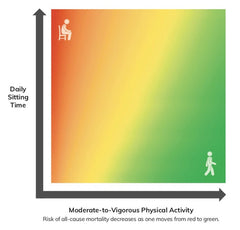Sit Less, Get Active
By Chuck Corbin, Arizona State University
AUGUST 2019
The National Health and Nutrition Examination Survey (NHANES) indicates that Americans spend too much time being sedentary. The term sedentary refers to behavior during the waking hours that has a low level of energy expenditure. This includes lying down, sitting, and anything else that has an energy expenditure of 1.5 METs or less (including behaviors such as TV watching and other screen time). According to NHANES, American children and adults spend 7.7 hours a day being sedentary. This amounts to more than half of waking time for most people.
A separate report, the Physical Activity Guidelines for Americans (USDHHS, 2018), indicates that there is a “strong relationship between time in sedentary behavior and risk of death from all causes” and that sedentary living increases the risk of heart disease, diabetes, and some forms of cancer. At this point, the scientific evidence is not sufficient to make a specific recommendation concerning limits on sedentary behavior. However, researchers have been able to determine that reducing sedentary behavior and increasing physical activity are good for your health.

The diagram shown here (from Physical Activity Guidelines for Americans, 2018) is useful in understanding how avoiding sedentary behavior and participating in moderate to vigorous physical activity (MVPA) can reduce the risk of disease and early death. In the diagram, red indicates high risk and green represents low risk. The greatest risk is created by a high amount of sedentary behavior and low amounts of MVPA (the red area in the upper left). The lowest risk is for people who limit sitting and engage in adequate MVPA (the lower right region in green). Reducing sedentary behavior is good, but this does not provide optimal risk reduction unless combined with being active on a regular basis. Being active is also good, but even active people have increased risk of disease if they sit too much.
The information conveyed in the diagram has significant implications for youth. For youth, being in school poses a public health threat because most of the time in school involves sitting. Comprehensive school physical activity programs (CSPAPs) that include quality physical education, physical activity before and after school, and physical activity during the school day (e.g., exercise breaks, recess) can enhance student fitness, health, and wellness by reducing sedentary time and increasing MVPA. Physical education helps get students active during the otherwise sedentary school day, but it has additional benefits as well. Quality physical education programs provide students with information and self-management skills that help them to be active outside of school—during the school years and beyond (Kulinna, Corbin, & Yu, 2018).
References
CDC. (n.d.). National health and nutrition examination survey (NHANES). Retrieved from www.cdc.gov/nchs/nhanes/about_nhanes.htm#content
Kulinna, P.H., Corbin, C.B., & Yu, H. (2018). Effectiveness of secondary school conceptual physical Education: A 20-year longitudinal study. Journal of Physical Activity and Health. 15(12), 1-6.
USDHHS. (2018). Physical activity guidelines for Americans. Retrieved from https://health.gov/paguidelines/second-edition/pdf/Physical_Activity_Guidelines_2nd_edition.pdf


Latest Posts
- Live Well Foundations of High School Health Teacher Collection
- Live Well Foundations of High School Health Bundle
- Live Well Foundations of High School Health Interactive Web Text
- Review of Adapted Physical Activity Across the Life Span
- Supporting Mental Health through Movement
- Review of Promoting Elementary School Physical Activity



